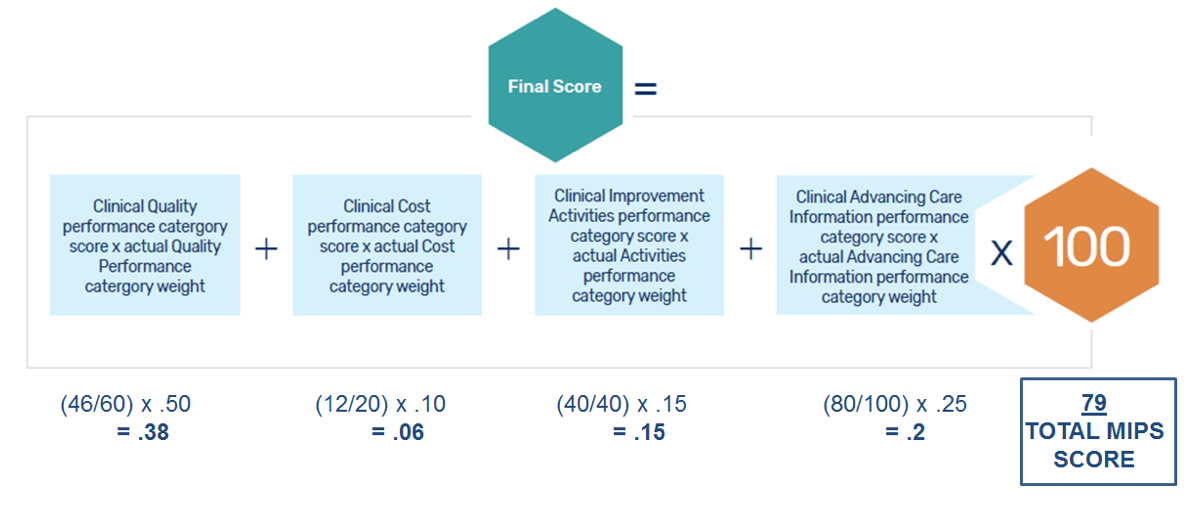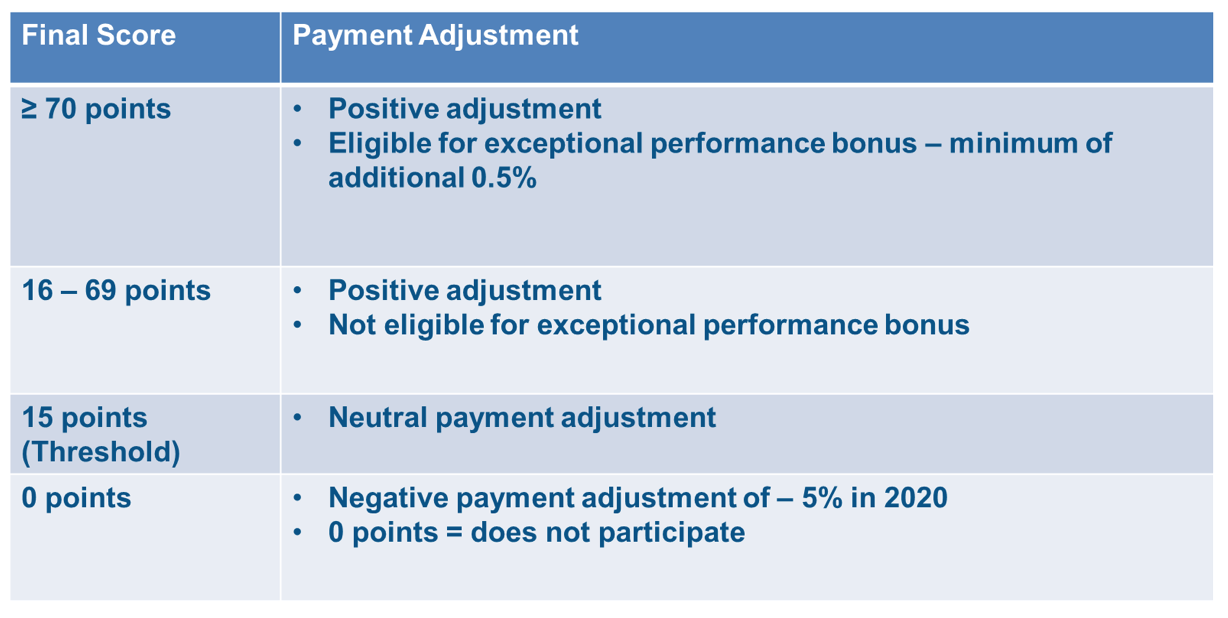 We are only 12 days away from officially closing out the 2017 Merit-based Incentive Payment System (MIPS) submission period! Hopefully most of you have everything squared away and are now strategizing for 2018!
We are only 12 days away from officially closing out the 2017 Merit-based Incentive Payment System (MIPS) submission period! Hopefully most of you have everything squared away and are now strategizing for 2018!
Now that the threshold has been bumped up to 15 points (to avoid a penalty in 2020), you will have to stay awake a little more than you did last year. However, how well you perform isn’t the only way to do well under MIPS. A lot of clinicians can boost their MIPS score by passively collecting bonus points.
It will have taken you longer to plan out your March Madness brackets than it will to accrue enough points to avoid a MIPS penalty with these bonus opportunities!
15 or bust
Before I get into the many ways to earn bonus points in 2018, let’s talk about the magic MIPS number for the year.
To avoid a -5% payment adjustment in 2020, you will need to earn at least 15 MIPS points. Considering the total number of MIPS points possible is 100, getting 15 points should be relatively easy.
Your MIPS score is calculated on a scale from 0 to 100. Each category in MIPS is given a category weight. The sum of all four categories will total 100 possible points.
The 4 MIPS Categories and Their Weights
Each MIPS category is scored separately as a percentage of maximum possible performance within that category. Each is also assigned a maximum number of “category-level” performance points.
- For quality, clinicians can earn up to 60 or 70 category-level points.
- For improvement activities, clinicians can earn up to 20 or 40 category-level points.
- For advancing care information (ACI), clinicians can earn up to 100 category-level points.
- For cost, clinicians can earn up to up to 20 category-level points.
Your category-level performance score will be determined by taking the total number of points you earned divided by the total number of points available in that category.
For example, if you earned 80 points in advancing care information, you would divide that by the 100 possible points available. This will give you a category level performance score of 80%.
You would then multiply that score by the overall category weight assigned (which is 25%). In this case .80 (category performance score) x .25 (overall category weight).
You will repeat this process for each category, add up all 4 scores, and then multiply by 100. This will be your MIPS composite performance score.
MIPS Final Score Calculation
Once your MIPS composite performance score is calculated, it will be compared against the threshold CMS has set for that performance year.
If you are below the threshold of 15, you will receive a penalty. If you are at the threshold of 15, you will remain neutral. If you are over the threshold of 15, you may earn bonus dollars. Clinicians with a score of 70 points or higher are eligible for not only a positive adjustment but also an exceptional performance bonus.
MIPS Composite Performance Scores and Payment Adjustments
Alright, now that we know how points are earned, let’s look at the many ways to earn bonus points!
Category-level Bonus Points
Each category under MIPS (except for improvement activities) has one or more ways to earn bonus points. The bonus points available below are added to your category-level performance (not your overall MIPS score). For example, if you earned 10 category-level bonus points under ACI, it would be added to the points you accrued in this category. If you scored 75 of 100 points under ACI and received 10 bonus points in this category, you would have a total category score of 85 points out of 100.
Clear as mud? Okay, let’s continue!
Advancing Care Information Bonus Points
- Using a CEHRT in 2015 (10 points)
Using a 2015 Certified Electronic Health Record (CEHRT) exclusively for the entire ACI reporting period will immediately earn you 10 bonus points. Acumen customers can count on this one!
- Using a CEHRT to report on Improvement Activities (10 points)
Using a CEHRT to meet an improvement activity can earn a maximum of 10 bonus points. Here is a list of improvement activities that qualify.
- Reporting to additional clinical registries/public health agencies (5 points)
Submitting to an additional public health agency or clinical data registry (not reported under the performance score) can earn a maximum of 5 bonus points.
Quality Bonus Points
- End-to-End Reporting (1 point/measure)
To receive the end-to-end bonus, the CEHRT system must directly send the data in the right format without any manual manipulation. If you’re only submitting eCQMs, your CEHRT can use the Quality Reporting Document Architecture (QRDA) III file format. Otherwise your CEHRT will need to directly send data to another third-party vendor (such as a Qualified Clinical Data Registry) for quality measure submission.
- Reporting additional outcome/high-priority measures
Submitting additional high priority measures (outside of the 1 required) will earn:- 2 bonus points for each extra outcome or patient experience measure
- 1 bonus point for each extra high-priority measure categorized as appropriate use, patient safety, efficiency, and care coordination
- Improvement scoring (Up to 10 points)
This bonus opportunity is new for year 2 of the MIPS program. As the name suggests, this bonus will be given only if a clinician has improved his/her quality score from last year.It will be calculated using the following formula:
Improvement percent score = (increase in quality performance category achievement percent score from prior performance period to current performance period / prior performance period quality performance category achievement percent score) x 10 percent
Cost Bonus Points
- Improvement scoring (up to 1 point)
This is the same concept as what is described above. Even though cost wasn’t calculated as part of your final MIPS score in 2017, cost was still measured (see your QRUR reports). If your cost score has improved from last year, you can earn up to 1 additional bonus point. More on this to come!
Overall MIPS Bonus Points
Unlike the bonus points I just covered, the following bonus points are applied to your final MIPS score (and not at the category-level). For those nephrologists in a small practice, the combination of these 2 bonus point opportunities will get you two-thirds of the way to the magic number 15 without having to do much!
- Small Practice Bonus (5 points)
Eligible clinicians that are in a small practice (defined as 15 or fewer clinicians under your TIN) can automatically add 5 points to their MIPS score if the eligible clinician submits data on at least 1 performance category!
- Complex Case Bonus (up to 5 points)
CMS will award up to 5 bonus points for clinicians who see a more complex patient population. Complexity is measured by using a Hierarchical Condition Category (HCC) risk score. The HCC score compares Medicare beneficiaries’ FFS spending to the overall average for the entire Medicare population.CMS created this bonus opportunity for two purposes: 1) to protect access to care for complex patients and provide them with excellent care and 2) to avoid placing MIPS-eligible clinicians who care for complex patients at a potential disadvantage.Do you know what specialty has the highest HCC score? NEPHROLOGY! The proposed rule states that nephrology has the highest average HCC risk score (3.05) among all other specialties (the average is 1.08)! It is safe to say, as a nephrologist you will mostly likely earn the full 5 bonus points.
Tally them up!
As you can see, getting the magic MIPS score of 15 this year shouldn’t be a problem. How you perform under MIPS isn’t the sole factor in your final score.
How many of these bonus point criteria apply to you?
- Nephrologist
- In a small practice (15 or fewer under your TIN)
- Use a 2015-edition EHR exclusively for ACI in 2018
- Choose additional outcome/high-priority quality measures
- Send to 2 or more clinical-data registries/public-health registries
- Submit quality measures via “end-to-end” electronic reporting
- Improved your quality and/or cost score from last year
I’m sure most of you can check at least 3 or more from that list above, which should put you in good shape. After all, half of the strategy behind a good MIPS score could be spent figuring out how to stack up bonus points!
 Diana Strubler, Policy and Standards Senior Manager, joined Acumen in 2010 as an EHR trainer then quickly moved into the role of certification and health IT standards subject matter expert. She has successfully led Acumen through three certifications while also guiding our company and customers through the world of Meaningful Use, ICD-10 and PQRS.
Diana Strubler, Policy and Standards Senior Manager, joined Acumen in 2010 as an EHR trainer then quickly moved into the role of certification and health IT standards subject matter expert. She has successfully led Acumen through three certifications while also guiding our company and customers through the world of Meaningful Use, ICD-10 and PQRS.
Image from www.canstockphoto.com







Leave a Reply